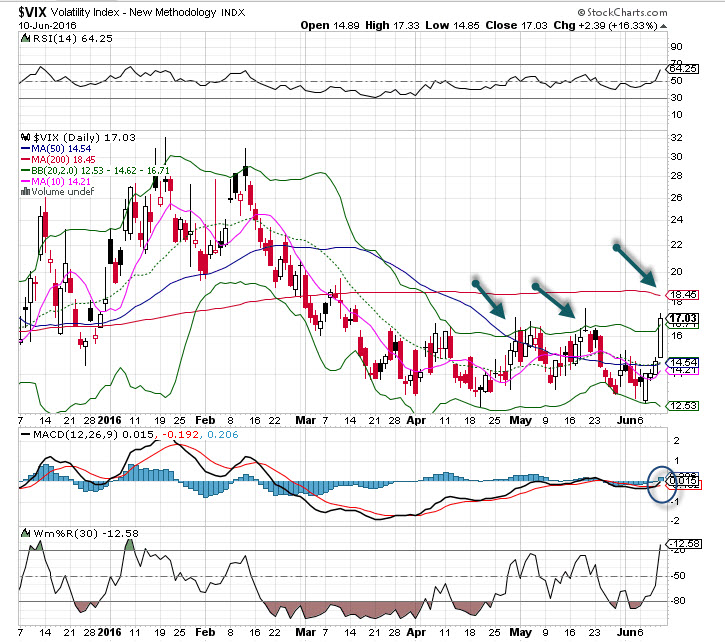Friday's risk off day was certainly one we have not seen in a few weeks. Bulls have had the advantage of late, and any spike in volatility was was sold down. Take a look at the VIX chart and you'll see the last two spikes prior to Friday (to 16 and then 17) were pulled down sharply by the end of the day. Yet, some fear seemed to seep in as we headed to the weekend. Was it warranted? I'm not so sure, but as we've seen when volatility has spiked previously, it may be time to be contrarian and look for the markets to reverse higher.
When we awoke Friday and saw Germany's DAX index down 2% and other European markets down sharply, it seemed the bulls were in for a challenging day. A no bid market with little to do but sell holdings and/or buy protection. On these risk off days, not only does volatility get bought, but we see a rise in the dollar, bonds and maybe gold as equities are shed. That was the case last Friday.
Why does the VIX run higher? Many call it the 'fear gauge', I prefer to call it the uncertainty index. Volatility rises not because of a fearful outcome, rather it rises when there is uncertainty about an outcome on the horizon. Currently we have a couple of outcomes that the market continues to wrangle with: Fed policy and a vote on British exit from the EU, or 'brexit'. For the former, the odds for a rate hike were raised sharply after some hawkish statements from Fed Governors - several of them in fact.

The chief complaint was that the market was not pricing in a potential rate hike at the June meeting, which in their view continues to be live. Expectations for a rate hike quickly surged from single digits to over 40% probability, but then the ugly jobs report on June 3 brought those expectations down to almost nil. The next meeting would be in July and that is currently a 1 in 5 chance. So, clearly the market is not worried about a rate hike or not, rather it's the confusion that persists around the event. Once the meeting is past I suspect the fear will again be removed. We have seen this happen at just about every meeting where there is confusion that ultimately gets settled. Markets move along their merry way.
Brexit is a completely different issue, and certainly there is no precedent yet for the outcome. The people of England will decide in a referendum whether they should leave the EU and their commitments. The latest polls show the outcome is a toss up - hence uncertainty over the result. The media has hyped this as something of an extreme material event, but in all likelihood this will just see currencies move wildly up and down. We nearly had a Greece expulsion from the EU last summer (grexit), and the fear rose sharply but only to decline once the issue was settled.
As we can see from the from the VSTOXX Futures chart (volatility from the euro stoxx 50 index) the curve is in backwardation. Simply put, market players are fearful of the unknown and buying short term protection via market puts, just in case something really bad occurs after the brexit vote. The media continues to show polls in favor or out of favor of brexit - that is going to capture everyone's attention.

The bottom line is this: When uncertainty rises and investors are unsure about an outcome, we see them looking for the exit door quickly. Volatility spikes, but as history has shown this is a temporary moment of insanity, and when the smoke clears markets often resume their previous path.